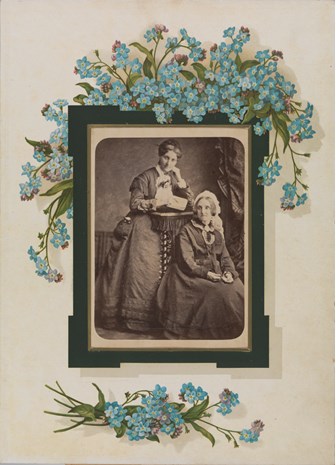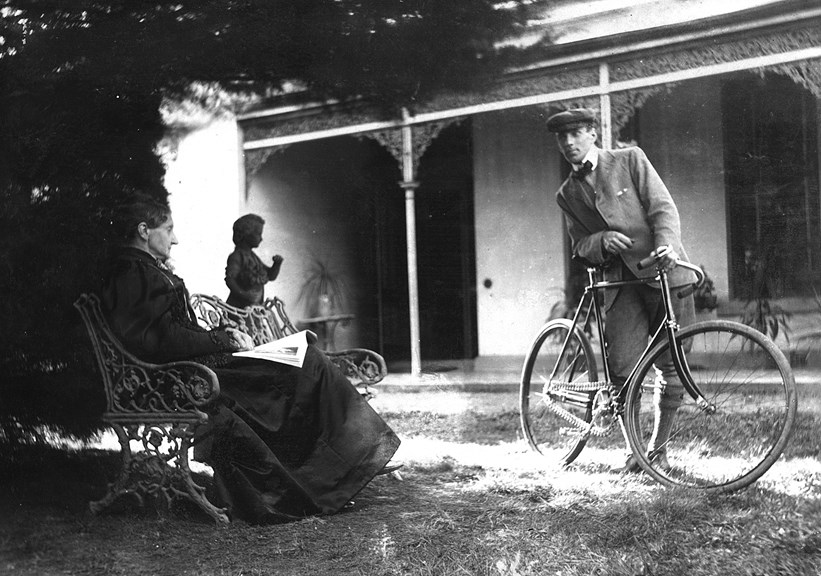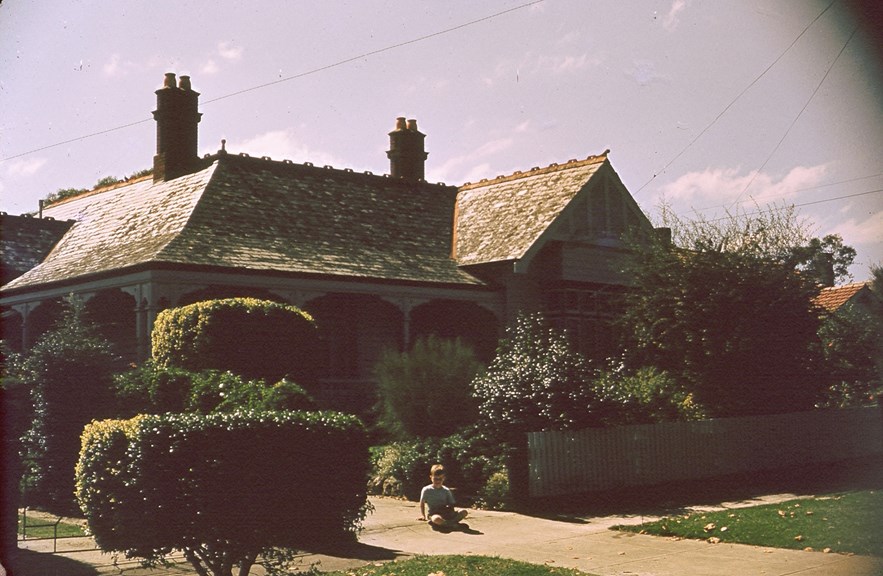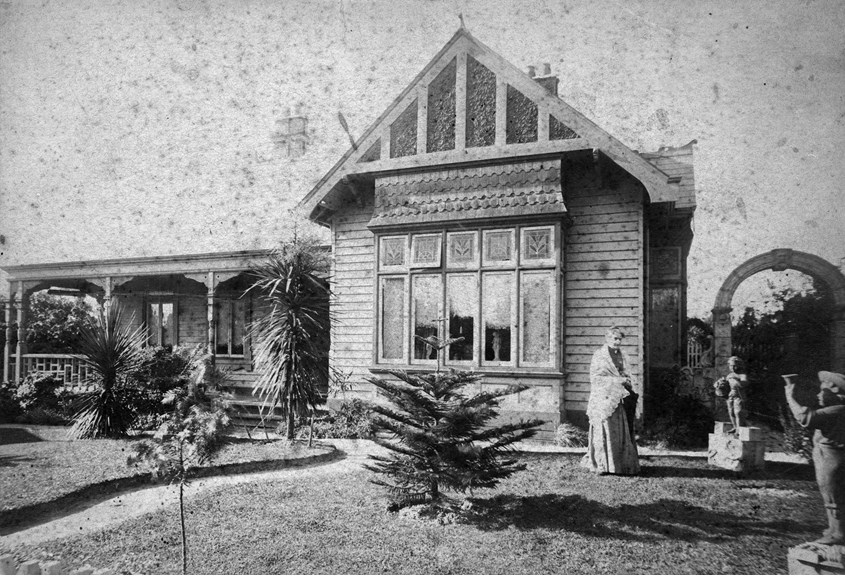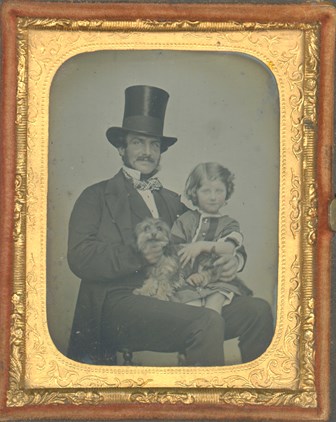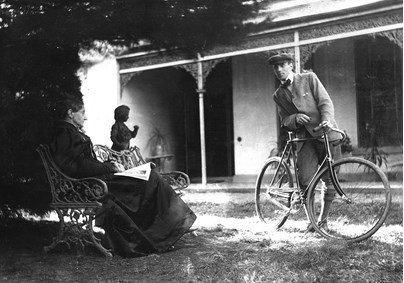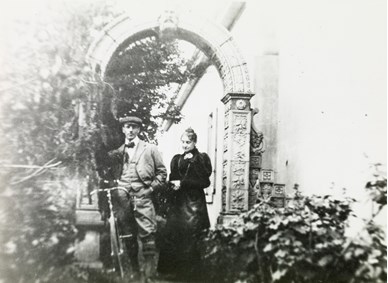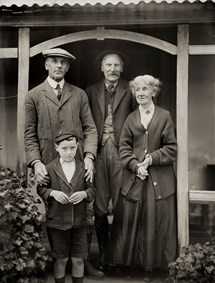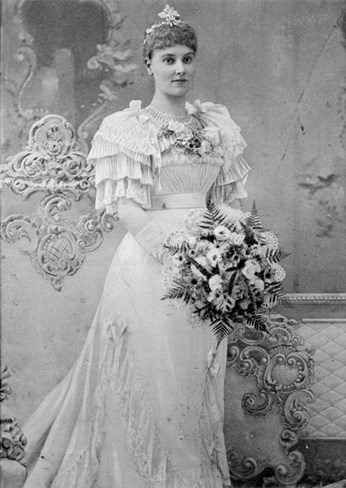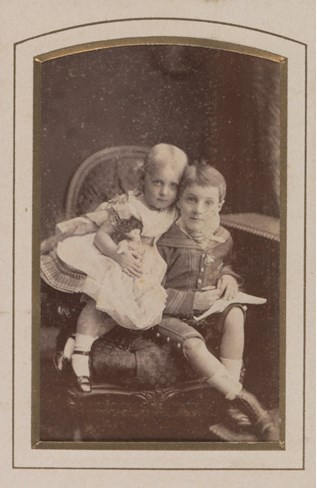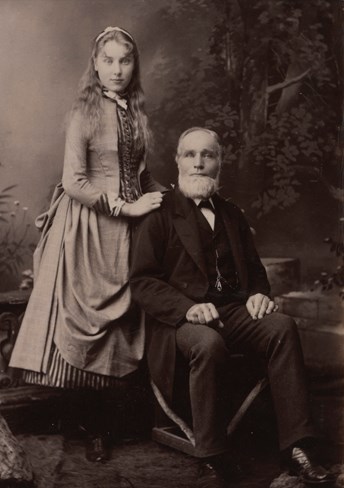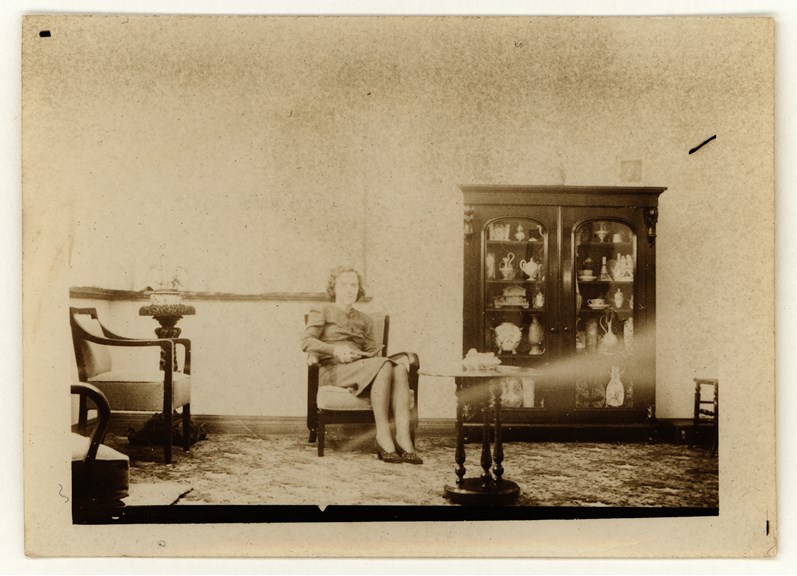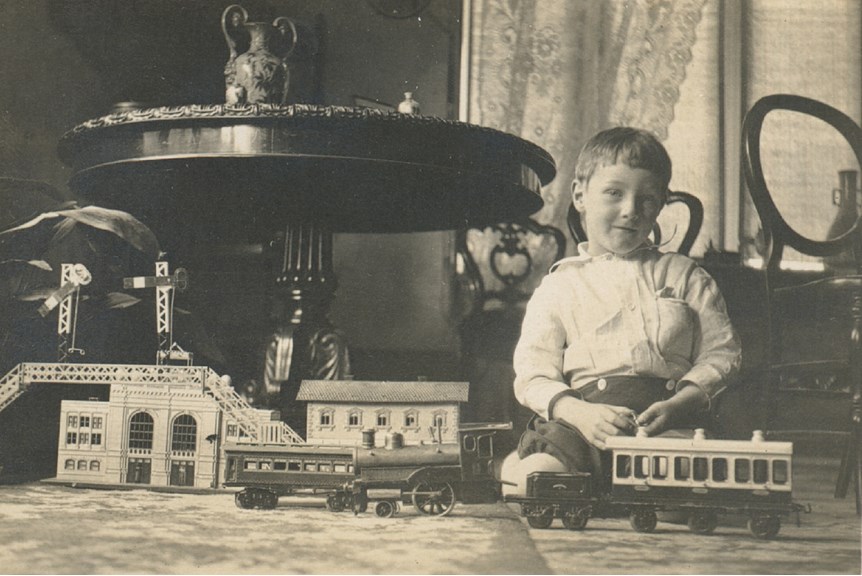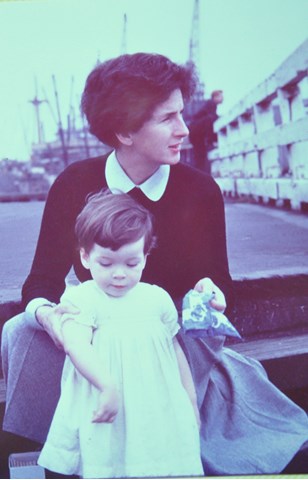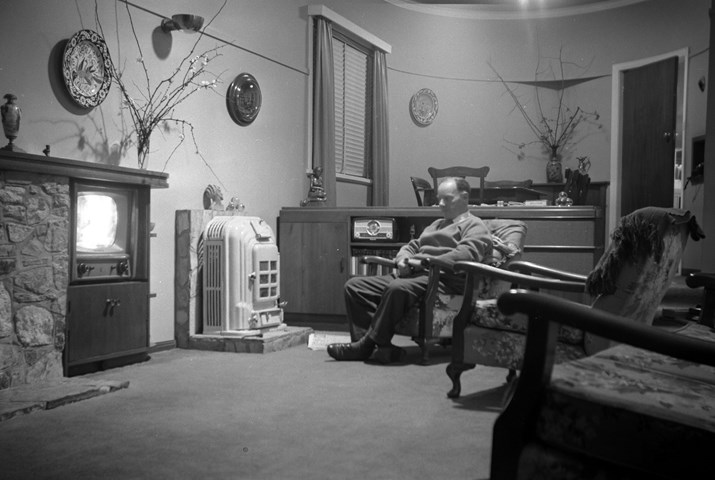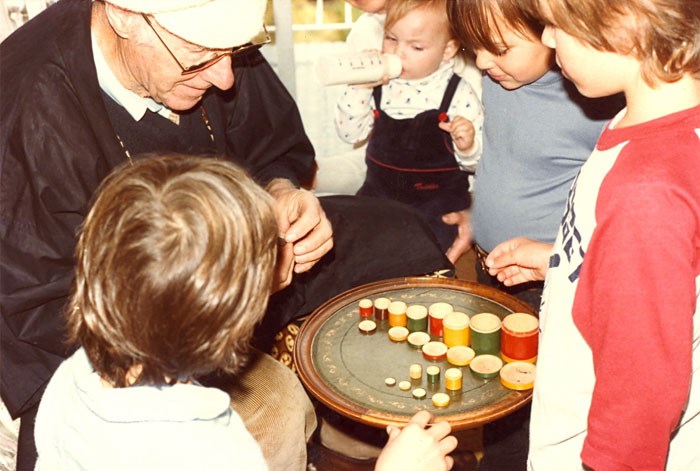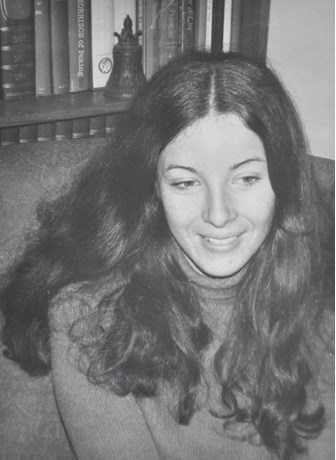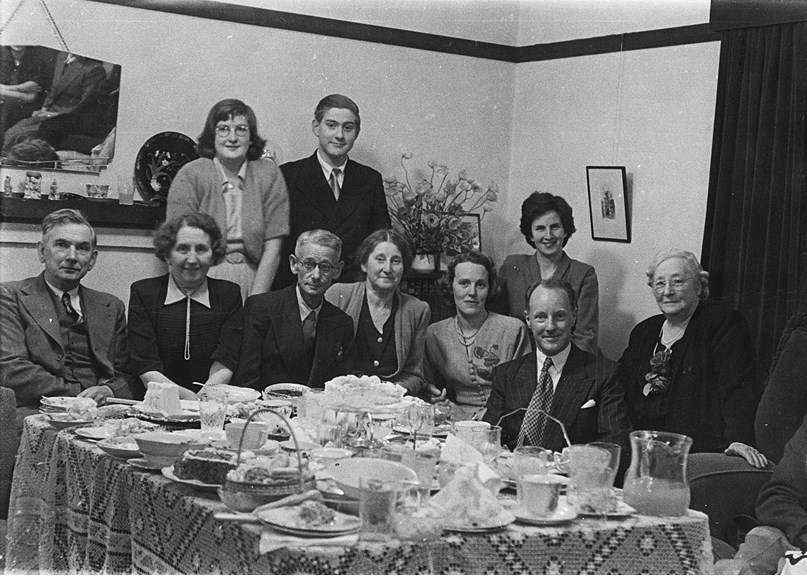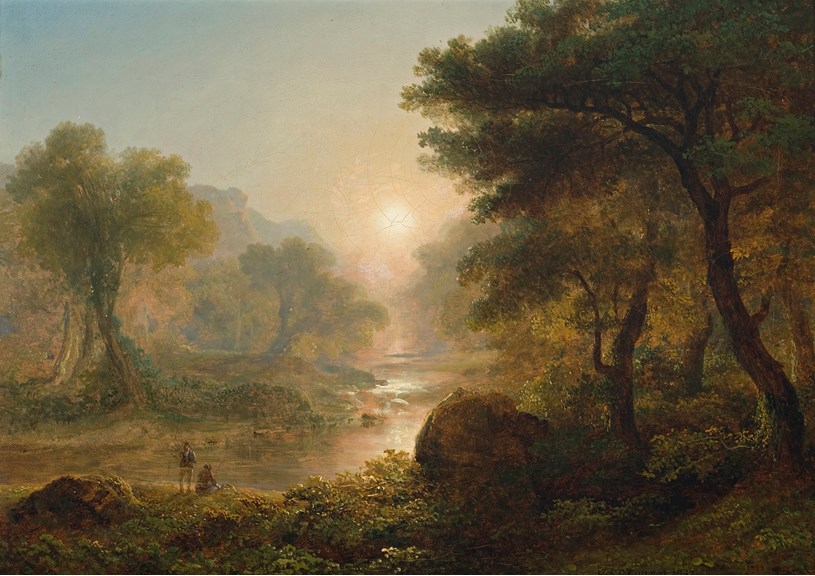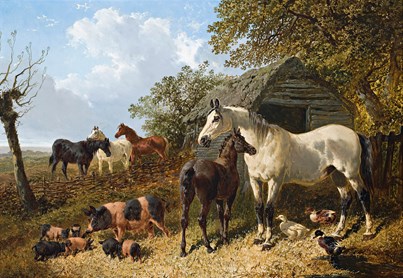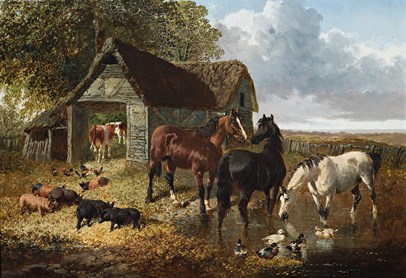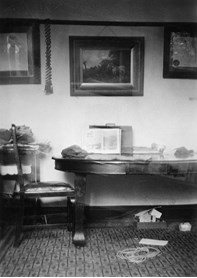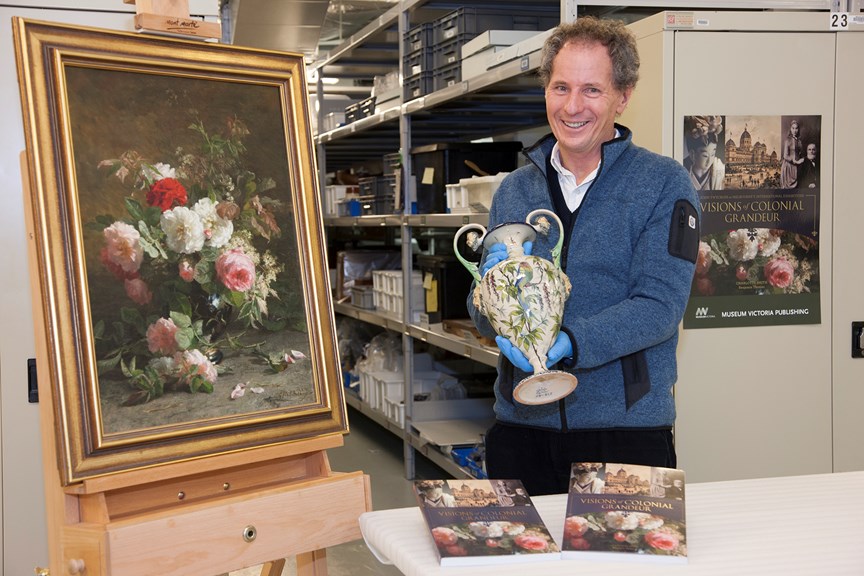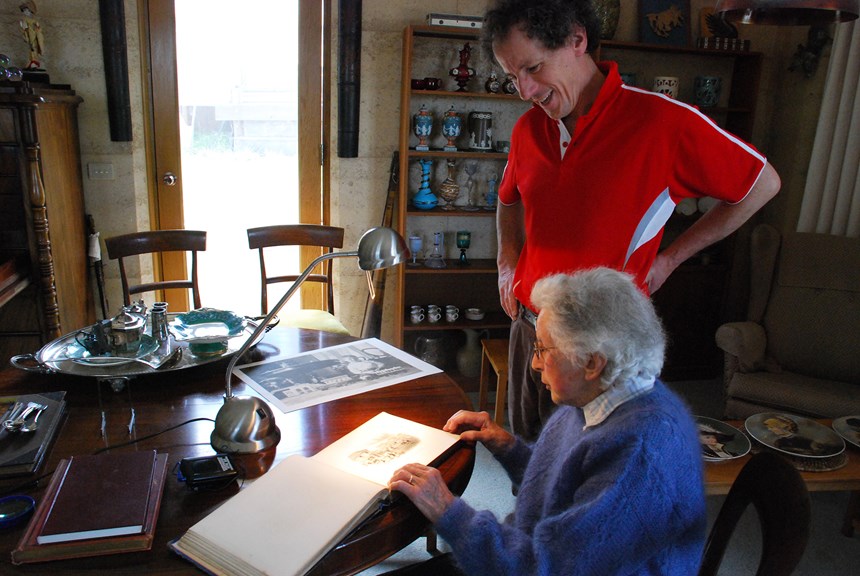The Curators
Following John Twycross' death in 1889, a large portion of his collection was sold at public auction. But not all.
Several hundred pieces were retained by his wife Lizzie, and distributed between her two children from her first marriage Arthur William D'Agnall (1857-1934) and Alfred Charles Ernest (1860-1941), and her two children with John Twycross, John 'Billie' William (1871-1936) and Ida Lilian Kate (1874-1943).
The collection became an important and defining element of the Twycross identity for the generations that followed.
Vases that were originally manufactured as pairs were separated and shared amongst the families. Japanese carved ivory okimono and netsuke were likewise distributed among the descendants of John and Lizzie Twycross.
As the family grew and moved addresses throughout the 20th century, the collection always followed. Cases were made especially to hold objects, houses were designed with the collection in mind. Objects hung on walls, displayed on book shelves, always present and reminding.
Before the collection was donated to Museum Victoria in 2009 by John Twycross' great grandchildren, Will and his sister Christine, Will reacquired collection items that had been dispersed among the family.
Explore the generations of Twycross' descendants, hear their stories, and see how the collection has been 'curated' by the family for more than a century.
Charlotte 'Lizzie' Twycross
Under the terms of her husband’s will, Lizzie Twycross was able to remain at Emmarine for the remainder of her life. For almost a decade, she lived there with her children John William, known as 'Billie', and Lilian.
Family photographs show her sitting out the front of the house on the cast iron garden seat made by the English firm of Coalbrookdale & Co. and purchased at the Melbourne Centennial International Exhibition.
By the end of the 1890s, Emmarine had become unnecessarily large for Lizzie and Lilian's needs. In 1906 they moved a few blocks north to a double-fronted weatherboard house at 23 Seymour Street, Elsternwick, which Lizzie named Emmarine after the family’s former home.
“This wrought iron Coalbrookdale garden seat on which Charlotte sits in silent reflection in front of Emmarine 1, at Glenhuntly Rd, Elsternwick, has continued over the years to be a valued place of contemplation and conversation for the Twycross family. It also features in many family photographs along with its partners, the round and the hexagonal table. It has lived in gardens from Elsternwick to Brighton to Launceston to Sydney.” — Christine Lopez (nee Twycross)
The stone archway which had previously stood at the entrance of the sideway of Emmarine on Glen Huntly road was transported, stone by stone, and re-erected at the edge of the front garden. The garden statues of young boys that had stood under the tree near the Coalbrookdale garden seat came too, reinstalled in the front garden of Seymour road, in front of the stone archway.
When Lizzie prepared her will a year before she died in 1908, she left Emmarine in Seymour road, and its contents, to Lilian and John William. To her boys from her first marriage she left land in England that she had inherited from her father, while any savings were to be shared equally amongst all four children.
The Twycross collection was distributed with the particular interests of the children in mind. Lilian, according to Lizzie's will, was to receive her jewellery, the dolls, and glassware; her brother, the weapons, a kris dagger from Indonesia and the Polynesian bow and arrows with their poisoned tips, the outdoor furniture, including the Coalbrookdale seat, garden urns, and ivory chess pieces. The remaining paintings, ceramics and paired items were shared between the two of them.
John William 'Billie' Twycross
John and Lizzie's eldest child, John William, was born in March 1871 while the family were still living in Alma Road, St Kilda, before they moved to Emmarine in Caulfield two years later.
When John Twycross visited the Melbourne International Exhibition in 1880, he almost certainly took his children with him, to marvel at the courts bursting with strange and interesting goods from the other side of the world. How many of the small Japanese carved okimono figures did they encourage their father to purchase?
Small figures of animals, fishermen, Chinese goddesses and Samurai families that looked more like toys than pieces of fine art. The brightly coloured cylindrical nesting boxes, stacked one inside the other, until the smallest one is recovered, like a Russian matryoshka doll, must surely have been the children's choice.
John William Twycross was among the first nine students to attend Caulfield Grammar School when it opened in 1881. Growing up surrounded by the art works that hung on the walls of Emmarine, he developed a keen interest in art, showing a natural talent for watercolour painting and photography. The family recall his ambition to pursue a career as a painter, and to travel to Europe and Italy. However the death of his father in 1889, and the economic downturn that followed, encouraged him to instead leave school early and join the Bank of New South Wales. He would remain with the Bank until his retirement.
In 1906, at Deniliquin in New South Wales, John married Frances Jane Fox, the daughter of a local builder. The couple returned to Melbourne and to the Twycross family home of Emmarine in Seymour road, Elsternwick, shortly before the outbreak of war in 1914. In April two years later, the couples only child, John Wilton Twycross, was born.
But while the Bank might have been John's career, art and photography were his passions. Aged 47 in 1918, he bought a Thornton-Pickard Westminster quarter plate camera, and for the following fourteen years would venture out around Melbourne and down the Mornington Peninsula, often with his young son, John Wilton, capturing landscapes, families at leisure along the Peninsula, and the city of Melbourne, returning to life after the sombre years of the First World War.
John's photographs throughout the 1920s provide a poetic and candid vision, not only of Melbourne at the time, but also the family and its legacy. Several of John's photos show four-year-old John Wilton playing with his train set on the drawing room floor of Emmarine in Seymour road, a Ginori majolica vase from his grandfather's collection positioned on the table behind him. Other images record excursions with his father to the Burrell's homestead at Arthur's Seat, looking out to sea through a telescope from the veranda, or feeding chickens with his Burrell relatives.
John William Twycross died in 1936, leaving his wife Frances and his son John Wilton the two beneficiaries of his estate, including Emmarine. The remaining collection of paintings, ceramics and art objects remained displayed in the house, to be appreciated by the following Twycross generation.
Ida Lilian Twycross
A student of the well-known Melbourne soprano Amelia Banks, Lilian joined the newly formed Australian Concert Company as a contralto singer in late 1894 and accompanied the Company to Hobart where they performed at the Tasmanian International Exhibition in December. The following year, she was appointed to St. Ambrose Church in Brunswick as contralto soloist.
It was her association, however, with the renowned elocutionist and voice coach Frederick M. Alexander that helped to firmly establish Lilian's reputation as a singer. Commencing as a pupil, she rose to become chief assistant of Alexander's studio. Sydney-based Alexander himself proudly declared that his successful student was 'the only certified teacher of my methods applied to the singing and speaking voice in Melbourne'. The English tenor William Parkinson, who moved to Australia in the 1880s, praised Lilian's voice as 'one of the finest in the colonies'.
In 1900, possibly while visiting her mother's family home at Arthur's Seat, she held singing lessons at McArthur's Coffee Palace at Mornington, owned by Peter and Grace McArthur. She evidently developed a close relationship with the McArthurs, and in November 1915 following Grace's death the previous December Lilian and Peter were married at the Presbyterian Church in Elsternwick.
Miss Twycross has received the highest praise from the press and public for her sympathetic singing, and Mr Parkinson (who is the leading authority on singing in Melbourne), considers her voice one of the finest in the colonies.Mornington Standard, 26 April 1900
Marriage and motherhood brought an end to Lilian's singing career. On 15 June 1917, she gave birth to her only child, Elizabeth Twycross McArthur. The family moved to Holcomb House, a guest-house on Mornington's The Esplanade that the McArthur's had purchased in 1906 after selling the Coffee Palace. The Twycross family recall that Lilian used to store items from her father's collection in the guest house's attic.
For almost twenty years, Peter and Lilian ran Holcomb House. After Peter died suddenly in April 1934, and Lilian's brother, John William Twycross, died in 1936, Holcomb House was put on the market and sold.
Lilian moved back to the Twycross family home of Emmarine in Seymour road, Elsternwick, to live with her widowed sister-in-law Frances, most probably bringing with her the objects she had had to store in the attic of Holcomb House. For a few years before her death in 1943, she lived in Balwyn.
She left those items from her father's collection in her possession to her daughter Elizabeth, and appointed her nephew John Wilton Twycross as executor of her will. Reflecting the close bond between Twycross and Clutterbuck families, she specified - should John Wilton be away on military service - that Bertie Hann, the husband of her step-niece, Dorothea Clutterbuck, was to act as executor. The Hann branch of the Clutterbuck family continues to retain fond memories and objects from John Twycross' collection today.
From a young age, Lilian Twycross was a gifted singer. In the mid-1890s, while still in her early 20s, she held singing classes at the family home of Emmarine in Seymour road, Elsternwick.
John Wilton and Mary Twycross (nee Rowe)
Born in 1916, John Wilton Twycross grew up in Emmarine, surrounded by the collection his grandfather had built up decades earlier.
The only child of John William and Frances Twycross (nee Fox), John Wilton often accompanied his father on his photographic excursions around Port Phillip Bay and down the Mornington Peninsula to visit his Aunt Lilian at Holcomb House on Mornington’s Esplanade, or further still to the Burrell homestead at Arthurs Seat. Here, more than seventy years earlier, his grandmother Lizzie Burrell had grown up. John's father probably told him stories about her. These were all he knew of her, for she had died in 1908, eight years before he was born.
The Twycross family remembers the bond between father and son being particularly close, such that when the Great Depression came in the late 1920s, John Wilton left school early to being working as an office boy in the same line of work as his father, at the Bank of New South Wales.
On 28 February 1942, John Wilton married Mary Rowe at St Andrew's Church of England in Brighton. At the time he was a lieutenant, having enlisted in the Australian Army in mid 1941. After he returned from World War II, John and Mary moved in with John's mother, Frances, still living at Emmarine in Elsternwick. He attended night school to study to become an accountant, continuing a career in banking, as the couple saved for their own home.
In the late 1940s John and Mary began to build their own Californian Bungalow-styled house, designed by Rhys Evan Hopkins, at 19 Plunket street in Brighton, part of a large-scale housing estate being developed to provide homes for returning soldiers.
John and Mary's son, Will, remembers growing up in the 1950s with neighbours who were all largely returned servicemen and their families. Even as late as 1963 they were 'quietly horrified', he recalls, when his parents visited Japan on the 50th anniversary of the death of John Milne, a renowned seismologist and nephew of John Twycross.
John Wilton designed the interiors of the family's new home in Plunket street to display his grandfather's collection. On the front lawn, near a willow that John had trained so carefully to weep to the ground and where a child might easily hide, stood the Coalbrookdale cast iron garden seat and hexagonal table. More than half a century earlier, they had graced the front garden of John and Lizzie Twycross original Emmarine on Glen Huntly road.
On a table, in the alcove of the drawing room, stood a small grouping of Japanese Satsuma ware vases, decoratively painted ceramic plates hung on walls, while Venetian glassware adorned the mantelpiece. Flower recesses were built into various rooms, and with an array of magnificent vases in the Twycross collection to choose from, Mary could indulge her passion for Japanese flower arrangement. Often sprigs of spring blossoms from the apple tree by the back fence would be used, and sometimes the lavish magnolia flowers.
On one of the shelves of 'the radiogram', a long built-in piece of furniture that separated the dining and living rooms, stood the caved Chinese chess pieces and the Japanese okimono and netsuke. In one of the cupboards at the end, John and Mary stored their wine glasses, but also other collection items, such as the cut-glass decanter.
The walls of the living room were decorated with glazed ceramic plates that hung above the television. The Twycrosses were the first family in Plunket street to have a TV, and the neighbours would gather in the family's living room in 1956 to watch the Melbourne Olympics. After work, having been picked up by Mary from Middle Brighton train station of an evening, John would settle in 'his' chair in front of the television, read the Herald newspaper, and watch the ABC news.
Christine Twycross
John and Mary's daughter Christine pays tribute to her parents' faith in the value of the collection and family memory, especially in the post-war era when anything old-fashioned was discarded:
"As busy young parents, mum and dad faced some unique challenges in preserving this collection. Over several interstate moves with the Bank of NSW, they continued to have faith in the value of keeping, displaying and caring for these objects that are now recognized as historic works of art. As Dad said, his grandmother, Charlotte, 'had kept her favourites'. Of necessity due to limited space, many things were stored carefully under our weatherboard house.
"To my father, these objects represented a treasured connection with the family legend of 'The Great Exhibition'. My mother - always loyal and intuitive - did as much personal research as she could in those days of scarce information and took responsibility for looking after the collection of 'things she had never seen before' but had grown to love."
Christine's memories of the home she grew up in are populated with images of collection objects:
"Treasures were mounted on the walls of the front hallway or placed into one of the built-in flower recesses. There, one of my mother's elegant Japanese styled flower arrangements stood in a vase made of Italian majolica decorated with a parrot and wisteria pattern. At the end of the hallway hung a small and delicate landscape of Eilean Donan castle in the highlands of Scotland. Hanging on the wall in a room just off the hallway was a cloisonné dish of cranes against an exquisitely coloured turquoise background: birds were intertwined in an Escher-like pattern: a treasure from Meiji Japan, which Great Grandfather had acquired as part of a glorious collection at the Great Exhibition some 70 years earlier. It was wildly beautiful and I often studied its intricate patterns.
"As I look back I realise that I lived in two worlds, but I got a good look at what Federation Australia had been all about, and I remember the feeling of being a small child visiting the old houses with the shaky dark brown floors, high door knobs, aspidistras and old ladies with kind blue eyes serving tea and scones, and the timeless feeling there was back then in the sleepy hot days. Late Victorian and Federation Australia lived on the walls and in the cupboards of my modern childhood home and I was so fortunate to experience it vicariously every day."
The Clutterbuck Legacy
In age, more like uncles than siblings to John Twycross' two children, Lizzie's two sons from her first marriage to Samuel Henry Clutterbuck - known as 'Henry' - were a close part of the Twycross family. Arthur William D'Agnall (1857-1934) and his younger brother Alfred Charles Ernest (1860-1941), known as Ernest, were regular visitors to Emmarine where they would have admired their step-father's extensive art collection.
That the two sets of siblings enjoyed a close, familial relationship is suggested in Lizzie's will. Both John William Twycross and Ernest Clutterbuck are listed as her executors. To her Clutterbuck sons, Lizzie left the entirety of land in England she had inherited from her father-in law, the boys' grandfather.
But even before her death, she had begun to distribute items from John Twycross' collection to Arthur and Ernest Clutterbuck.
A painting by the Irish artist James Arthur O'Connor, titled Irish Landscape, had been put up for auction in 1889 as part of the sale of the Twycross collection. It must not have attracted a bidder, for it remained in the family of Clutterbuck descendants until being sold in 2009. Two further paintings, farmyard scenes by the English artist John Herring, did find buyers at the 1889 auction sale, the pair of them selling for £44. But perhaps one of the brothers bought them, for these too remained in the family until sold, along with the O'Connor.
These paintings, and possibly others long since forgotten about, joined Japanese carved ivory okimono and other small items that are still retained by the descendants of the Clutterbuck brothers today; the continuing legacy of John Twycross' collection.
Will Twycross
"I grew up in a weatherboard house that contained European paintings, intricately carved ivory chess pieces, brilliantly coloured ceramics, and long Polynesian arrows that we were told were poison tipped and shouldn't be touched. I played with the chess pieces behind the couch ... but never touched the arrows. The paintings with their strange scenes and exotic colours hung on the walls, breathing the soft mists of Europe into the harsh sunlight of the suburbs.
"The ceramics, I realised afterwards, sat in alcoves which had been carefully designed for specific pieces. The house had been designed by my parents after my father had returned from the Second War, and in effect, in this modest dwelling, form followed function. Much less grand, but in intent, what my great grandfather had done in building his art wing in the previous century. As I grew older, I was told these exotic objects were all from "The Great Exhibition", and came to understand the reverence in which they were held.
"We were very fortunate that in 2004 the Royal Exhibition Building gained World Heritage Status and came under the management of Museums Victoria. This coincided with the time that our parents, as they grew old, passed the collection to our care. My mother had curated the collection for many years and was very pleased when we decided to return it to the place it had come from. The decision seemed to have a certain symmetry to it.
"One interesting thing was that our great grandparents bequeathed different parts of the collection to their two children, and with the help of our cousins, we were able to round out the collection by securing items that had come down their side of the family such as English glassware and Sèvres porcelain.
"Preserving the items as a collection and being able to donate it into the public domain is an outcome which honours the aesthetic desires and memory of our grandparents, and for us, has been a matter of good fortune."
